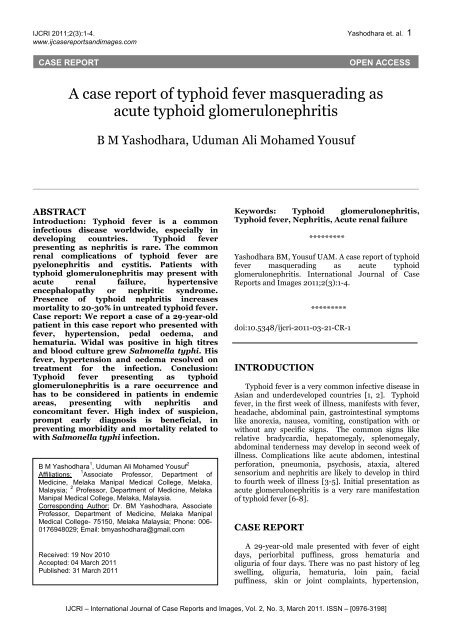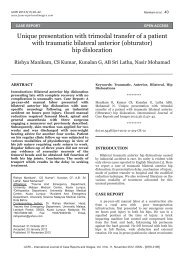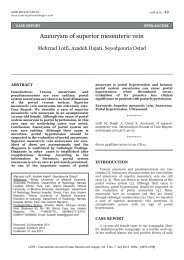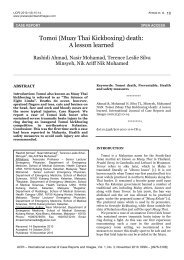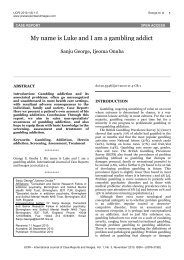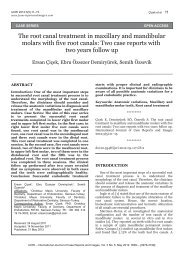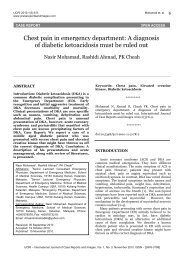A case report of typhoid fever masquerading as - International ...
A case report of typhoid fever masquerading as - International ...
A case report of typhoid fever masquerading as - International ...
Create successful ePaper yourself
Turn your PDF publications into a flip-book with our unique Google optimized e-Paper software.
IJCRI 2011;2(3):1-4. Y<strong>as</strong>hodhara et. al. 1<br />
www.ij<strong>c<strong>as</strong>e</strong><strong>report</strong>sandimages.com<br />
CASE REPORT<br />
OPEN ACCESS<br />
A <strong>c<strong>as</strong>e</strong> <strong>report</strong> <strong>of</strong> <strong>typhoid</strong> <strong>fever</strong> <strong>m<strong>as</strong>querading</strong> <strong>as</strong><br />
acute <strong>typhoid</strong> glomerulonephritis<br />
B M Y<strong>as</strong>hodhara, Uduman Ali Mohamed Yousuf<br />
ABSTRACT<br />
Introduction: Typhoid <strong>fever</strong> is a common<br />
infectious dise<strong>as</strong>e worldwide, especially in<br />
developing countries. Typhoid <strong>fever</strong><br />
presenting <strong>as</strong> nephritis is rare. The common<br />
renal complications <strong>of</strong> <strong>typhoid</strong> <strong>fever</strong> are<br />
pyelonephritis and cystitis. Patients with<br />
<strong>typhoid</strong> glomerulonephritis may present with<br />
acute renal failure, hypertensive<br />
encephalopathy or nephritic syndrome.<br />
Presence <strong>of</strong> <strong>typhoid</strong> nephritis incre<strong>as</strong>es<br />
mortality to 20-30% in untreated <strong>typhoid</strong> <strong>fever</strong>.<br />
C<strong>as</strong>e <strong>report</strong>: We <strong>report</strong> a <strong>c<strong>as</strong>e</strong> <strong>of</strong> a 29-year-old<br />
patient in this <strong>c<strong>as</strong>e</strong> <strong>report</strong> who presented with<br />
<strong>fever</strong>, hypertension, pedal oedema, and<br />
hematuria. Widal w<strong>as</strong> positive in high titres<br />
and blood culture grew Salmonella typhi. His<br />
<strong>fever</strong>, hypertension and oedema resolved on<br />
treatment for the infection. Conclusion:<br />
Typhoid <strong>fever</strong> presenting <strong>as</strong> <strong>typhoid</strong><br />
glomerulonephritis is a rare occurrence and<br />
h<strong>as</strong> to be considered in patients in endemic<br />
are<strong>as</strong>, presenting with nephritis and<br />
concomitant <strong>fever</strong>. High index <strong>of</strong> suspicion,<br />
prompt early diagnosis is beneficial, in<br />
preventing morbidity and mortality related to<br />
with Salmonella typhi infection.<br />
B M Y<strong>as</strong>hodhara 1 , Uduman Ali Mohamed Yousuf 2<br />
Affiliations:<br />
1 Associate Pr<strong>of</strong>essor, Department <strong>of</strong><br />
Medicine, Melaka Manipal Medical College, Melaka,<br />
Malaysia; 2 Pr<strong>of</strong>essor, Department <strong>of</strong> Medicine, Melaka<br />
Manipal Medical College, Melaka, Malaysia.<br />
Corresponding Author: Dr. BM Y<strong>as</strong>hodhara, Associate<br />
Pr<strong>of</strong>essor, Department <strong>of</strong> Medicine, Melaka Manipal<br />
Medical College- 75150, Melaka Malaysia; Phone: 006-<br />
0176948029; Email: bmy<strong>as</strong>hodhara@gmail.com<br />
Received: 19 Nov 2010<br />
Accepted: 04 March 2011<br />
Published: 31 March 2011<br />
Keywords: Typhoid glomerulonephritis,<br />
Typhoid <strong>fever</strong>, Nephritis, Acute renal failure<br />
*********<br />
Y<strong>as</strong>hodhara BM, Yousuf UAM. A <strong>c<strong>as</strong>e</strong> <strong>report</strong> <strong>of</strong> <strong>typhoid</strong><br />
<strong>fever</strong> <strong>m<strong>as</strong>querading</strong> <strong>as</strong> acute <strong>typhoid</strong><br />
glomerulonephritis. <strong>International</strong> Journal <strong>of</strong> C<strong>as</strong>e<br />
Reports and Images 2011;2(3):1-4.<br />
*********<br />
doi:10.5348/ijcri-2011-03-21-CR-1<br />
INTRODUCTION<br />
Typhoid <strong>fever</strong> is a very common infective dise<strong>as</strong>e in<br />
Asian and underdeveloped countries [1, 2]. Typhoid<br />
<strong>fever</strong>, in the first week <strong>of</strong> illness, manifests with <strong>fever</strong>,<br />
headache, abdominal pain, g<strong>as</strong>trointestinal symptoms<br />
like anorexia, nausea, vomiting, constipation with or<br />
without any specific signs. The common signs like<br />
relative bradycardia, hepatomegaly, splenomegaly,<br />
abdominal tenderness may develop in second week <strong>of</strong><br />
illness. Complications like acute abdomen, intestinal<br />
perforation, pneumonia, psychosis, ataxia, altered<br />
sensorium and nephritis are likely to develop in third<br />
to fourth week <strong>of</strong> illness [3-5]. Initial presentation <strong>as</strong><br />
acute glomerulonephritis is a very rare manifestation<br />
<strong>of</strong> <strong>typhoid</strong> <strong>fever</strong> [6-8].<br />
CASE REPORT<br />
A 29-year-old male presented with <strong>fever</strong> <strong>of</strong> eight<br />
days, periorbital puffiness, gross hematuria and<br />
oliguria <strong>of</strong> four days. There w<strong>as</strong> no p<strong>as</strong>t history <strong>of</strong> leg<br />
swelling, oliguria, hematuria, loin pain, facial<br />
puffiness, skin or joint complaints, hypertension,<br />
IJCRI – <strong>International</strong> Journal <strong>of</strong> C<strong>as</strong>e Reports and Images, Vol. 2, No. 3, March 2011. ISSN – [0976-3198]
IJCRI 2011;2(3):1-4. Y<strong>as</strong>hodhara et. al. 2<br />
www.ij<strong>c<strong>as</strong>e</strong><strong>report</strong>sandimages.com<br />
Figure 1: Compares acute <strong>typhoid</strong> nephritis with acute post-streptococcal glomerulonephritis.<br />
generalised weakness and other renal related<br />
problems. There w<strong>as</strong> also no history <strong>of</strong> any drug<br />
intake, sore throat or skin infections in the recent p<strong>as</strong>t.<br />
On examination oral temperature w<strong>as</strong> 101 degree F,<br />
pulse rate w<strong>as</strong> 90 beats/min, and blood pressure w<strong>as</strong><br />
170/100 mm <strong>of</strong> Hg. He had periorbital and facial<br />
puffiness, bilateral pedal oedema, elevated jugular<br />
venous pulse <strong>of</strong> 6 cm from sterna angle and 4 cm nontender<br />
hepatomegaly from right costal margin, 3 cm<br />
spleenomegaly from the left costal margin. There w<strong>as</strong><br />
no free fluid in the abdomen and no tenderness<br />
anywhere in the abdomen including renal angle<br />
tenderness. Other systemic examination for<br />
cardiov<strong>as</strong>cular, respiratory, central nervous and<br />
musculoskeletal system were essentially normal. His<br />
urine output from 1 st to 5 th day in the hospital w<strong>as</strong> 300<br />
to 400 ml/day with gross hematuria.<br />
Laboratory investigations: Haemoglobin w<strong>as</strong> 11<br />
gm/dl, total leukocyte count w<strong>as</strong> 4300 cells/cumm<br />
with 40% neutrophils, 58% lymphocytes and 2%<br />
b<strong>as</strong>ophils and ESR w<strong>as</strong> 40 mm/1 st hr. Urine<br />
examination showed hematuria on gross examination,<br />
confirmed by microscopic examination, with crenated<br />
red blood cells (RBCs) and RBC c<strong>as</strong>ts. There w<strong>as</strong> urine<br />
proteinuria <strong>of</strong> 860 mg/24 hours <strong>of</strong> urine collection.<br />
His serum creatinine w<strong>as</strong> 3.5 mg/dl, and blood urea<br />
w<strong>as</strong> 45 mg/dl. His liver function tests, ECG, Chest X-<br />
ray were within normal limits. His first Widal test<br />
IJCRI – <strong>International</strong> Journal <strong>of</strong> C<strong>as</strong>e Reports and Images, Vol. 2, No. 3, March 2011. ISSN – [0976-3198]
IJCRI 2011;2(3):1-4. Y<strong>as</strong>hodhara et. al. 3<br />
www.ij<strong>c<strong>as</strong>e</strong><strong>report</strong>sandimages.com<br />
yielded antibody titre for O antigen <strong>of</strong> 1:160, H antigen<br />
1:160 which w<strong>as</strong> done on the first day <strong>of</strong> admission and<br />
rose to a titre <strong>of</strong> 1:640 on the 8 th <strong>of</strong> admission. Blood<br />
culture w<strong>as</strong> positive for Salmonella typhi; sensitive to<br />
cetriaxone, cefotaxime, and quinalones but resistant to<br />
amoxicillin and ampicillin. At all times, titres for AH<br />
and BH (Para<strong>typhoid</strong> A and B) were negative. Urine<br />
culture for urinary tract infection did not yield any<br />
growth. Serology for HIV, HBsAg, and hepatitis C were<br />
negative. Antinuclear antibody, malaria par<strong>as</strong>ite<br />
antigen and peripheral smear for malarial par<strong>as</strong>ite<br />
were all negative. C-reactive protein w<strong>as</strong> 6 mg/dl and<br />
Anti-steptolysin antibody w<strong>as</strong> negative.<br />
Ultr<strong>as</strong>onography showed mild hepatosplenomegaly<br />
and normal sized kidneys.<br />
He w<strong>as</strong> treated with intravenous (IV) ceftriaxone 2<br />
gm/day for 10 days, salt and fluid restriction, oral<br />
atenolol 50 mg/day once a day and frusemide 40<br />
mg/day and bed rest. He became afebrile on 4 th day <strong>of</strong><br />
admission. He started p<strong>as</strong>sing good volume <strong>of</strong> urine<br />
from day five <strong>of</strong> admission with gradual disappearance<br />
<strong>of</strong> hematuria. Blood pressure w<strong>as</strong> well controlled to<br />
130/80 mm <strong>of</strong> Hg from day two <strong>of</strong> admission. Blood<br />
culture done on 6 th day <strong>of</strong> illness w<strong>as</strong> sterile.<br />
Microscopic hematuria w<strong>as</strong> improving although<br />
persisted upto 10 days <strong>of</strong> admission and then<br />
disappeared during outpatient follow up. His blood<br />
urea and serum creatinine started to normalise and<br />
were completely normal on discharge. However, mild<br />
proteinuria persisted at 120 mg/day during outpatient<br />
follow up, but it w<strong>as</strong> much lower <strong>as</strong> compared to time<br />
<strong>of</strong> presentation. Kidney biopsy w<strong>as</strong> not done in view <strong>of</strong><br />
rapid recovery.<br />
DISCUSSION<br />
Our patient w<strong>as</strong> a 29-year-old adult. He presented<br />
with <strong>fever</strong>, oliguria, oedema, proteinuria, hypertension<br />
and azotemia. Urine microscopy showed crenated red<br />
cells. All these features suggested glomeruloneprhitis<br />
with acute renal failure, which promptly recovered<br />
with treatment <strong>of</strong> <strong>typhoid</strong>. Typhoid <strong>fever</strong> is a very<br />
common infective dise<strong>as</strong>e. Common early presentation<br />
<strong>of</strong> <strong>typhoid</strong> <strong>fever</strong> is insidious onset <strong>of</strong> continuous <strong>fever</strong>,<br />
with nonspecific malaise, myalgia, arthralgia,<br />
headache, nausea, anorexia, constipation. In first week<br />
<strong>of</strong> illness signs are usually not present [2-5].<br />
Hepatosplenomegaly, relative bradycardia and<br />
tenderness in right iliac fossa tend to develop in second<br />
week <strong>of</strong> illness. Uncommon manifestations like altered<br />
sensorium, prolonged pyrexia, pneumonia, intestinal<br />
perforation, intestinal hemorrhage, myocarditis, septic<br />
shock, meningitis, parotitis, osteomyelitis, orchitis,<br />
nephritis may present by third to fourth week <strong>as</strong><br />
complications <strong>of</strong> untreated or multi drug resistant<br />
<strong>c<strong>as</strong>e</strong>s [2-4, 9]. They are very rare nowadays owing to<br />
availability <strong>of</strong> early diagnosis and treatment [4, 10].<br />
Typhoid <strong>fever</strong> <strong>m<strong>as</strong>querading</strong> <strong>as</strong> acute<br />
glomerulonephritis is a very rare entity and occurs in<br />
Table 1: Renal Manifestations <strong>of</strong> Typhoid <strong>fever</strong><br />
Bacilluria<br />
Proteinuria<br />
Hematuria following <strong>typhoid</strong> vaccination<br />
Acute tubular necrosis with acute renal failure<br />
Cystitis<br />
Pyeloneprhitis<br />
Acute interstitial nephritis<br />
Acute glomerulonephritis<br />
Ig A nephropathy<br />
Postvaccinal nephropathy<br />
2-3% <strong>of</strong> all <strong>c<strong>as</strong>e</strong>s [7]. Renal involvement in <strong>typhoid</strong> is<br />
called ‘nephro<strong>typhoid</strong>’ [4, 10]. Renal manifestations <strong>of</strong><br />
<strong>typhoid</strong> <strong>fever</strong> are shown in the table 1.<br />
The usual renal manifestations in <strong>typhoid</strong> are<br />
presence <strong>of</strong> red blood and white blood cells in urine,<br />
albuminuria, azotemia, nephritis, renal failure and<br />
pyelonephritis [6-8, 10, 11]. Glomerulonephritis and<br />
acute interstitial nephritis due to <strong>typhoid</strong> are very<br />
uncommon [11-13].<br />
Glomerulonephritis in <strong>typhoid</strong> is due to immune<br />
complex mediated glomerular damage and it can cause<br />
hematuria and/or proteinuria. Biopsy shows diffuse<br />
proliferative glomerulonephritis with deposits <strong>of</strong> IgM,<br />
complement C3 and Vi antigen in glomerular capillary<br />
wall [2, 4, 6, 10]. Renal failure in <strong>typhoid</strong> may be a part<br />
<strong>of</strong> septicemia or shock. Symptomless bacilluria may<br />
occur in 20-25% <strong>of</strong> <strong>typhoid</strong> <strong>fever</strong>. This is not a<br />
complication <strong>as</strong> this bacilluria is temporary and<br />
kidneys purely act <strong>as</strong> organs <strong>of</strong> excretion, without itself<br />
being the seat <strong>of</strong> <strong>typhoid</strong> lesions [4]. Typhoid nephritis<br />
in adults, <strong>as</strong> a complication <strong>of</strong> untreated <strong>typhoid</strong><br />
carries a very high mortality <strong>of</strong> 20-30% [6, 7].<br />
Hypocomplementamia is uncommon in <strong>typhoid</strong><br />
nephritis in comparison to acute streptococcal<br />
glomerulonephritis (Figure 1). This could be due to<br />
host factors, although HLA haploid- type link h<strong>as</strong> not<br />
been proven, for normal complement levels in <strong>typhoid</strong><br />
glomerulonephritis [14]. In certain geographic<br />
locations <strong>typhoid</strong> nephritis needs to be considered <strong>as</strong> a<br />
possibility in patients with nephritis and concomitant<br />
<strong>fever</strong> [7, 14]. Other types <strong>of</strong> renal involvement in<br />
<strong>typhoid</strong> <strong>fever</strong> are: Ig A nephropathy [15] and postvaccination<br />
nephropathy [16] following <strong>typhoid</strong><br />
vaccination. Most patients with enteric<br />
glomerulonephritis present with acute renal failure,<br />
hypertensive encephalopathy or nephritic syndrome<br />
and prompt recovery on treating <strong>typhoid</strong> <strong>fever</strong> with IV<br />
ceftriaxone or other antibiotics [8]. Interestingly<br />
complications <strong>of</strong> <strong>typhoid</strong> <strong>fever</strong> like hepatitis and<br />
nephritis were more common in females in one<br />
particular study, implicating host’s immune response<br />
to acute <strong>typhoid</strong> infection [17]. Jaundice due to <strong>typhoid</strong><br />
hepatitis, which may be seen in upto 50% patients with<br />
<strong>typhoid</strong> [18], may precipitate the occurrence <strong>of</strong> <strong>typhoid</strong><br />
glomerulonephritis [19]. As such, the <strong>typhoid</strong> hepatitis<br />
and <strong>typhoid</strong> nephritis occurring simultaneously in a<br />
IJCRI – <strong>International</strong> Journal <strong>of</strong> C<strong>as</strong>e Reports and Images, Vol. 2, No. 3, March 2011. ISSN – [0976-3198]
IJCRI 2011;2(3):1-4. Y<strong>as</strong>hodhara et. al. 4<br />
www.ij<strong>c<strong>as</strong>e</strong><strong>report</strong>sandimages.com<br />
patient with <strong>typhoid</strong> is very rare [20], but may be more<br />
common in HIV positive patients with <strong>typhoid</strong> <strong>fever</strong><br />
[21]. Very rarely acute renal failure in <strong>typhoid</strong> <strong>fever</strong><br />
may occur due intrav<strong>as</strong>cular hemolysis caused by<br />
<strong>typhoid</strong> <strong>fever</strong> [18]. Awareness <strong>of</strong> rare manifestations <strong>of</strong><br />
this common infectious illness, early recognition and<br />
prompt treatment is instrumental in reducing<br />
morbidity and mortality.<br />
CONCLUSION<br />
Typhoid nephritis is a rare complication <strong>of</strong> <strong>typhoid</strong><br />
<strong>fever</strong> with significant morbidity and mortality. In<br />
endemic are<strong>as</strong> for <strong>typhoid</strong> <strong>fever</strong>, <strong>typhoid</strong> nephritis<br />
should be suspected in patients with nephritis and<br />
concomitant <strong>fever</strong>. In patients presenting with <strong>fever</strong>,<br />
diarrhea, hepatosplenomegaly, positive blood culture<br />
for <strong>typhoid</strong> <strong>fever</strong> and positive Widal test, <strong>typhoid</strong><br />
nephritis and renal failure could be e<strong>as</strong>ily detected by<br />
urine examination and renal function tests. Early<br />
treatment <strong>of</strong> <strong>typhoid</strong> <strong>fever</strong> with intravenous antibiotics<br />
and fluid management prevents further progression <strong>of</strong><br />
<strong>typhoid</strong> nephritis and impending dialysis.<br />
*********<br />
Author Contributions<br />
Y<strong>as</strong>hodhara BM – Substantial contributions to<br />
conception and design, Acquisition <strong>of</strong> data, Drafting<br />
the article, Revising it critically for important<br />
intellectual content, Final approval <strong>of</strong> the version to be<br />
published<br />
Uduman Ali Mohamed Yousuf – Substantial<br />
contributions to conception and design, Analysis and<br />
interpretation <strong>of</strong> data, Drafting the article, Final<br />
approval <strong>of</strong> the version to be published<br />
Guarantor<br />
The corresponding author is the guarantor <strong>of</strong><br />
submission.<br />
Conflict <strong>of</strong> Interest<br />
Authors declare no conflict <strong>of</strong> interest.<br />
Copyright<br />
© BM Y<strong>as</strong>hodhara et. al. 2011; This article is<br />
distributed under the terms <strong>of</strong> Creative Commons<br />
attribution 3.0 License which permits unrestricted use,<br />
distribution and reproduction in any means provided<br />
the original authors and original publisher are properly<br />
credited. (Ple<strong>as</strong>e see www.ij<strong>c<strong>as</strong>e</strong><strong>report</strong>sandimages.com<br />
/copyright-policy.php for more information.)<br />
REFERENCES<br />
1. Typhoid <strong>fever</strong>, Park K, Park’s Textbook <strong>of</strong><br />
Preventive and Social Medicine. 16 th edn. Jabalpur,<br />
Banarsid<strong>as</strong> Bhanot 1999:175-178.<br />
2. Richens J. Typhoid and Para<strong>typhoid</strong> <strong>fever</strong>s. Oxford<br />
textbook <strong>of</strong> Medicine 3 rd edn, ELBS 1996;1:560-567.<br />
3. Christie AB. Typhoid and Para<strong>typhoid</strong> <strong>fever</strong>.<br />
Infectious dise<strong>as</strong>es, Churchchill Livingstone<br />
1987;81:100-163.<br />
4. Kelkar PN, James E. Review article on <strong>typhoid</strong><br />
<strong>fever</strong>. J Assoc Physicians India 1977;45: 37-48.<br />
5. Wongsawat J, Pancharoen C, Thisyakorn U.<br />
Typhoid <strong>fever</strong> in children: experience in King<br />
Chulalongkorn Memorial Hospital. J Med Assoc<br />
Thai 2002;85(12):1247-1250.<br />
6. Choudury, Sproo etal. Typhoid nephritis. J Assoc<br />
Physicians India 1988;36:447-448.<br />
7. Bukva I, Coovadia HM. Typhoid<br />
glomerulonephritis. Arch Dis Child 1980;55:305-<br />
307.<br />
8. Parmar RC, Bavdekar SB, Houilgol R, Muranjan<br />
MN. Nephritis and cerebellar ataxia: rare<br />
presenting features <strong>of</strong> enteric <strong>fever</strong>. J Postgrad Med<br />
2000;46(3):184-186.<br />
9. Kabra SK, Madhulika, Talati A, Soni N, Patel S,<br />
Modi RR. Multidrug-resistant <strong>typhoid</strong> <strong>fever</strong>. Trop<br />
Doct 2000;30(4):195-197.<br />
10. Williams DC, Adu D. Infection <strong>as</strong>sociated<br />
nephropathy. Oxford text book <strong>of</strong> Medicine, 3 rd edn,<br />
ELBS 1996;3:3173-3179.<br />
11. Dönmez O, Başdemir G. Presentation <strong>of</strong> a <strong>c<strong>as</strong>e</strong> with<br />
Salmonella glomerulonephritis. Turk J Pediatr<br />
2002;44(3):267-268.<br />
12. Pancharoen C, Wongsawat J, Phancharoen S,<br />
Thisyakorn U. Typhoid glomerulonephritis in a<br />
child: a rare complication <strong>of</strong> <strong>typhoid</strong> <strong>fever</strong>.<br />
Southe<strong>as</strong>t Asian J Trop Med Public Health 2001;<br />
32(4):869-871.<br />
13. Caers J, Peeters P, Vanden Houte K, Sennesael J,<br />
Van der Niepen P, Ver. Acute interstitial nephritis<br />
<strong>as</strong>sociated with salmonellosis. Eur J Intern Med<br />
2006;17(3):217-219.<br />
14. Katz Y, Azizi E, Eshel G, Mundel G. Familial<br />
occurrence <strong>of</strong> <strong>typhoid</strong> acute glomerulonephritis. Isr<br />
J Med Sci 1987;23(3):199-201.<br />
15. Indrapr<strong>as</strong>it S, Boonpucknavig V, Boonpucknavig S.<br />
IgA nephropathy <strong>as</strong>sociated with enteric <strong>fever</strong>.<br />
Nephron 1985;40(2):219-22.<br />
16. Giudicelli CP, Nedelec G, Doulcet E, Falcot J, Girier<br />
L. Renal risk <strong>of</strong> vaccinations. Prospective survey<br />
and retrospective study. Presse Med 1983;<br />
12(25):1587-1590.<br />
17. Khan M, Coovadia YM, Connolly C, Sturm AW.<br />
Influence <strong>of</strong> sex on clinical features, laboratory<br />
findings, and complications <strong>of</strong> <strong>typhoid</strong> <strong>fever</strong>. Am J<br />
Trop Med Hyg 1999;61(1):41-46.<br />
18. Ozen H, Seçmeer G, Kanra G, Ecevit Z, Ceyhan M,<br />
Dursun A, Anlar Y. Typhoid <strong>fever</strong> with very high<br />
transamin<strong>as</strong>e levels. Turk J Pediatr 1995;37(2):169-<br />
171.<br />
19. Khan M, Coovadia YM, Kar<strong>as</strong> JA, Connolly C, Sturm<br />
AW. Clinical significance <strong>of</strong> hepatic dysfunction<br />
with jaundice in <strong>typhoid</strong> <strong>fever</strong>. Dig Dis Sci 1999;<br />
44(3):590-594.<br />
20. Khan M, Coovadia Y, Sturm AW. Typhoid <strong>fever</strong><br />
complicated by acute renal failure and hepatitis:<br />
<strong>c<strong>as</strong>e</strong> <strong>report</strong>s and review. Am J G<strong>as</strong>troenterol<br />
1998;93(6):1001-1003.<br />
21. Khan M, Coovadia Y, Sturm AW. Typhoid <strong>fever</strong> and<br />
<strong>as</strong>ymptomatic human immunodeficiency virus<br />
infection. A <strong>report</strong> <strong>of</strong> 10 <strong>c<strong>as</strong>e</strong>s. J Clin G<strong>as</strong>troenterol<br />
1997;25(3):507-512.<br />
IJCRI – <strong>International</strong> Journal <strong>of</strong> C<strong>as</strong>e Reports and Images, Vol. 2, No. 3, March 2011. ISSN – [0976-3198]


